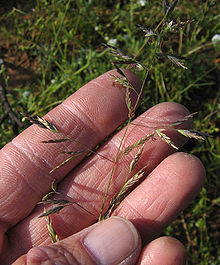|
Poa secunda
Poa secunda (variously known by the common names of Sandberg bluegrass,[2][3][4] alkali bluegrass,[4] big bluegrass,[4] Canby's bluegrass,[2] Nevada bluegrass,[4] one-sided bluegrass,[3] Pacific bluegrass,[2] pine bluegrass,[2] slender bluegrass,[2] wild bluegrass,[4] and curly bluegrass[1]) is a widespread species of perennial bunchgrass native to North and South America.[4] It is highly resistant to drought conditions, and provides excellent fodder;[3] and has also been used in controlling soil erosion,[4] and as revegetator,[4] often after forest fires.[6] Cultivars include 'Canbar', 'Service', 'Sherman', and 'Supernova'.[7] Historically, indigenous Americans, such as the Gosiute of Utah, have used P. secunda for food.[8] It was originally described botanically in 1830 by Jan Svatopluk Presl, from a holotype collected from Chile by Thaddäus Haenke in 1790.[2] Native distribution
References
  External linksWikimedia Commons has media related to Poa secunda.
|
||||||||||||||||||||||||||||||||||||||

